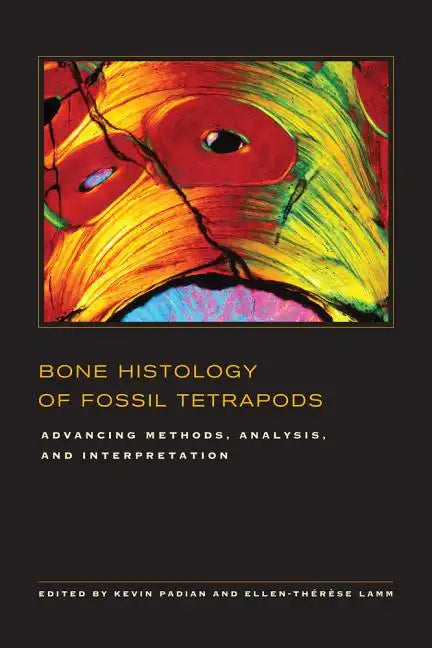Bone Histology of Fossil Tetrapods: Advancing Methods, Analysis, and Interpretation - Hardcover
Bone Histology of Fossil Tetrapods: Advancing Methods, Analysis, and Interpretation - Hardcover
Couldn't load pickup availability
by Kevin Padian (Editor), Ellen-Thérèse Lamm (Editor)
The microscopic examination of fossilized bone tissue is a sophisticated and increasingly important analytical tool for understanding the life history of ancient organisms. This book provides an essential primer and manual for using fossil bone histology to investigate the biology of extinct tetrapods. Twelve experts summarize advances in the field over the past three decades, reviewing fundamental basics of bone microanatomy and physiology. Research specimen selection, thin-section preparation, and data analysis are addressed in detail. The authors also outline methods and issues in bone growth rate calculation and chronological age determination, as well as how to examine broader questions of behavior, ecology, and evolution by studying the microstructure of bone.
Front Jacket
In recent years, a veritable avalanche of studies has demonstrated the enormous value of the study of bone microstructure for assessing growth and other aspects of the biology of extinct vertebrates. This volume is not only an excellent, well-illustrated review of this subject, but also a how-to manual of methods for study and analysis. As such, it is an indispensable reference for researchers who use bone histology to test paleobiological hypotheses.--Hans-Dieter Sues, National Museum of Natural History
This is a must-have book if you're interested in the bone histology of dinosaurs and other archosaurs. From the acquisition of bone specimens, to what to do with them, to understanding their significance from metabolism to growth, this volume has it all.--David B. Weishampel, senior editor of The Dinosauria
9780520273559|JF|Ultimately, we can all trace our origins back to the savannas of Africa. Robin Reid's book provides an eloquent introduction into the biology of the savannas that shaped us as humans; simultaneously, she provides an insightful and comprehensive overview of current and future threats to East African savannas and the steps that need to be taken to conserve the world we first lived in. Don't go to East Africa without first reading this book; it will enhance your safari and empower your research.-Andrew P. Dobson, author of Conservation and Biodiversity
Savannas of Our Birth provides a balanced, scientific, and accessible examination of the current state of East African savannas and the relationships among the wildlife and people who live there. Reid examines how savannas came to be and what alternative futures may be possible by trying to chart a middle ground in contentious debates about conservation and local rights.-J. Terrence McCabe, author of Cattle Bring Us to Our Enemies: Turkana Ecology, History, and Raiding in a Disequilibrium System
Reid's research focusing on pastoralists has reminded me that wildlife and domestic livestock co-existed to their mutual benefit for the last 2000 years. With reopened eyes, I've even seen it for myself in the case of the Masai and the savanna wildlife I study. There is an extraordinary wealth of information in this book.-Richard D. Estes, author of The Behavior Guide to African Mammals
9780520273566|JF|Usable Social Science represents a remarkable collaboration between Neil J. Smelser, one of America's most distinguished sociologists, and John Reed, a highly successful member of corporate America. Together, they accomplish an even more remarkable feat of making accumulated social science knowledge accessible to non-academics while, at the same time, making an academic contribution to the social sciences by reviewing the history, accumulated findings, and conceptual approaches in key areas of specialization in sociology and elsewhere in the social sciences.--Jonathan H. Turner, University Professor & Distinguished Professor of Sociology, University of California, Riverside.
This book is an ambitious project to provide the public with a review of the available and practicable knowledge for decision-making people (and who is not that today?) that the social sciences have produced over the last 250 years or so. Typically, such efforts are bound to fail. But this project is a full success, keeping its promise to present knowledge in an understandable and exciting way. The language is charming and the elegant prose is the product of a fluent, transparent style. In short: a must read!"--Hans-Peter Mueller, Professor of sociology, Humboldt-University of Berlin.
Back Jacket
In recent years, a veritable avalanche of studies has demonstrated the enormous value of the study of bone microstructure for assessing growth and other aspects of the biology of extinct vertebrates. This volume is not only an excellent, well-illustrated review of this subject, but also a how-to manual of methods for study and analysis. As such, it is an indispensable reference for researchers who use bone histology to test paleobiological hypotheses.--Hans-Dieter Sues, National Museum of Natural History
"This is a must-have book if you're interested in the bone histology of dinosaurs and other archosaurs. From the acquisition of bone specimens, to what to do with them, to understanding their significance from metabolism to growth, this volume has it all."--David B. Weishampel, senior editor of The Dinosauria
Author Biography
Kevin Padian is Professor of Integrative Biology at the University of California, Berkeley and Curator at the UC Museum of Paleontology. Ellen-Thérèse Lamm is Histology Laboratory Manager at the Museum of the Rockies in Bozeman, Montana.


